As devastating as floods and forest fires can be, most of those pale in comparison with the potential threat posed by volcanoes. Volcanic eruptions are among the most destructive natural events on Earth, combining ash clouds, lava streams, landslides and earthquakes.
This also makes visiting a volcano a more than averagely exciting thing to do. In the United States alone, there are no fewer than ten national parks with volcanoes you can visit.
The U.S. is one of the world’s most volcanically active countries, home to more than 10% of known active and potentially active volcanoes on Earth. There’s volcanic activity all along its Pacific coast, as well as on the Hawaiian Islands and in Alaska.
Many—if not most—volcanoes in national parks of America pose a “very high threat” according to the U.S. Geological Survey National Volcanic Threat Assessment. Those include volcanic landscapes that may seem super-peaceful right now, such as those at Crater Lake and around Mount Rainier.
Yet, the realization that you’re in the vicinity of a mountain that most likely will erupt or explode sometime in the future is an exhilarating thought, making your visit even more special and thrilling.
This national parks with volcanoes in America post contains affiliate links. You can read more about our Terms of Use / Disclosure here.
Contents
- 10 National Parks With Volcanoes in America
- Mount Rainier National Park, Washington
- Crater Lake National Park, Oregon
- Lassen Volcanic National Park, California
- Death Valley National Park, California
- Hawai’i Volcanoes National Park, Hawaii
- Haleakala National Park, Hawaii
- Katmai National Park, Alaska
- Lake Clark National Park, Alaska
- Wrangell-St. Elias National Park, Alaska
- Yellowstone National Park, Wyoming, Idaho and Montana
- Major National Park Volcanoes in America
- Other Pacific Northwest Volcano Parks in the United States
- Other Best National Parks for…
10 National Parks With Volcanoes in America
If you’ve ever hiked the Skyline Trail Loop in Mount Rainier National Park, watched wildlife in Yellowstone or drove around Crater Lake, you’ve been in some of Earth’s most dangerous volcanic environments.
In these volcanoes national parks, you’ll find everything from new-land-creating lava flows and explosive geysers to peaceful lakes and massive glaciers. They’re all home to active volcanoes, some of which are among the world’s most dangerous volcanoes.
All of the national parks with volcanic activity are in the Western U.S., situated along or near the so-called Pacific Ring of Fire.
They include many of the greatest national parks in America, famous for everything from waterfalls and wildflowers to architecture and scenic drives.
Mount Rainier National Park, Washington
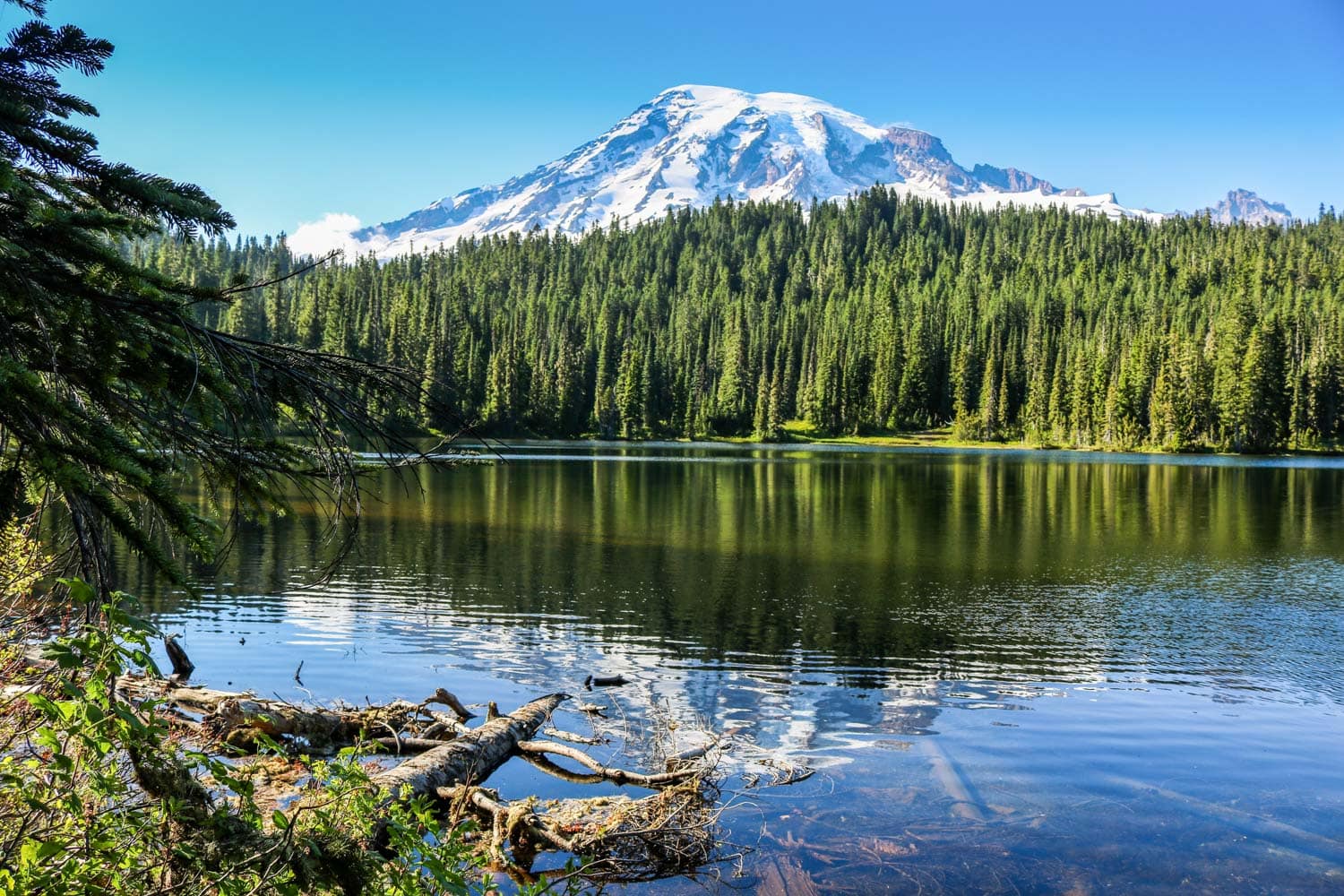
Reaching 14,411 feet (4,392 meters) toward the heavens, Mount Rainier is the tallest mountain in the Pacific Northwest’s Cascade Range. This massive stratovolcano dominates the Washington landscape, rising abruptly from the surrounding mountains and countryside.
No other mountain in the lower 48 states is as topographically prominent as Mount Rainier. If you’re looking for a super-impressive volcano in a national park, Mount Rainier is one of your most accessible options.
Additionally, the mountain also has the most glaciers of any mountain in the contiguous United States, the source of five major rivers in the region.
This massive amount of ice combined with its volcanic activity and proximity to a large city like Seattle makes it one of the world’s sixteen most dangerous volcanoes, known collectively as the “Decade Volcanoes”.
Mount Rainier National Park is centered on this iconic mountain, which is called Tacoma by Native Americans.
In this park, you’ll find a plethora of attractions, such as waterfalls, epic hiking trails, spectacular summer wildflower displays, abundant wildlife and beautiful fall colors. It makes for a great road trip destination from Portland or Seattle.
Crater Lake National Park, Oregon
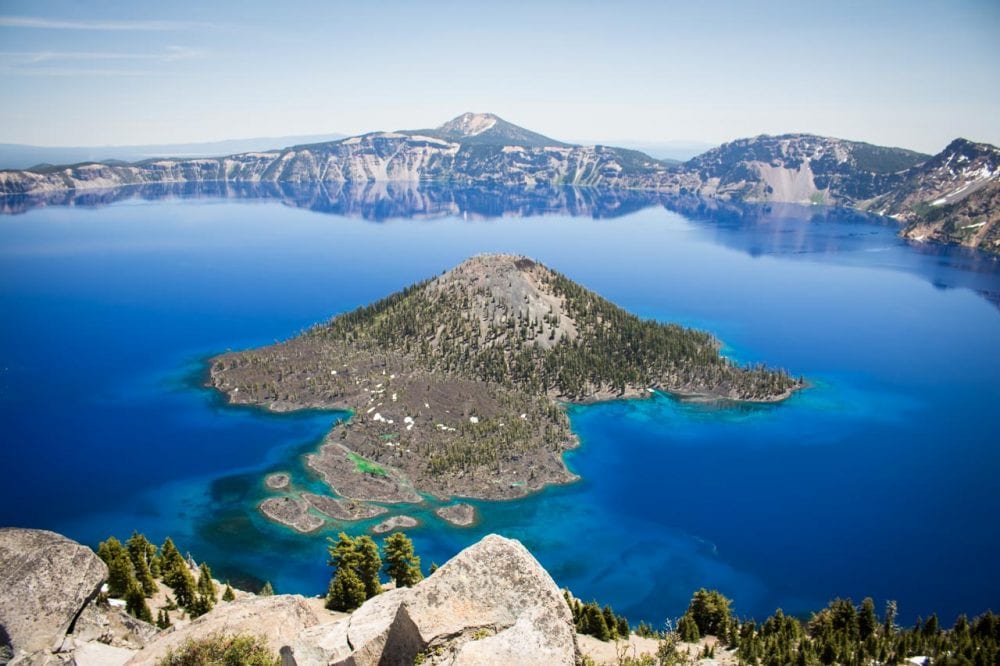
One of the many volcanic features in the Cascade Volcanic Arc, Crater Lake National Park is the only national park in Oregon. Created 7,700 years ago, when the violent eruption of Mount Mazama caused the mountain to collapse into itself, this is America’s deepest and clearest lake—1,949 feet (594 meters) deep.
Getting its water solely from precipitation and snowmelt, Crater Lake is also one of the purest lakes on Earth. Its calm blue water is stunning, especially on a sunny day, while the dramatic cliffs and surrounding pumice plains remind visitors of the immense cataclysm that once happened here.
The lake’s Wizard Island is still an active cinder cone, making this is one of a limited number of places where you can see a volcano within a volcano.
Crater Lake National Park is also amazingly easy to explore. One of the greatest national parks roads, the Rim Drive allows visitors to drive, hike or snowshoe around the entire lake and see it from every possible angle. There are a few great hikes at Crater Lake, too!
Lassen Volcanic National Park, California
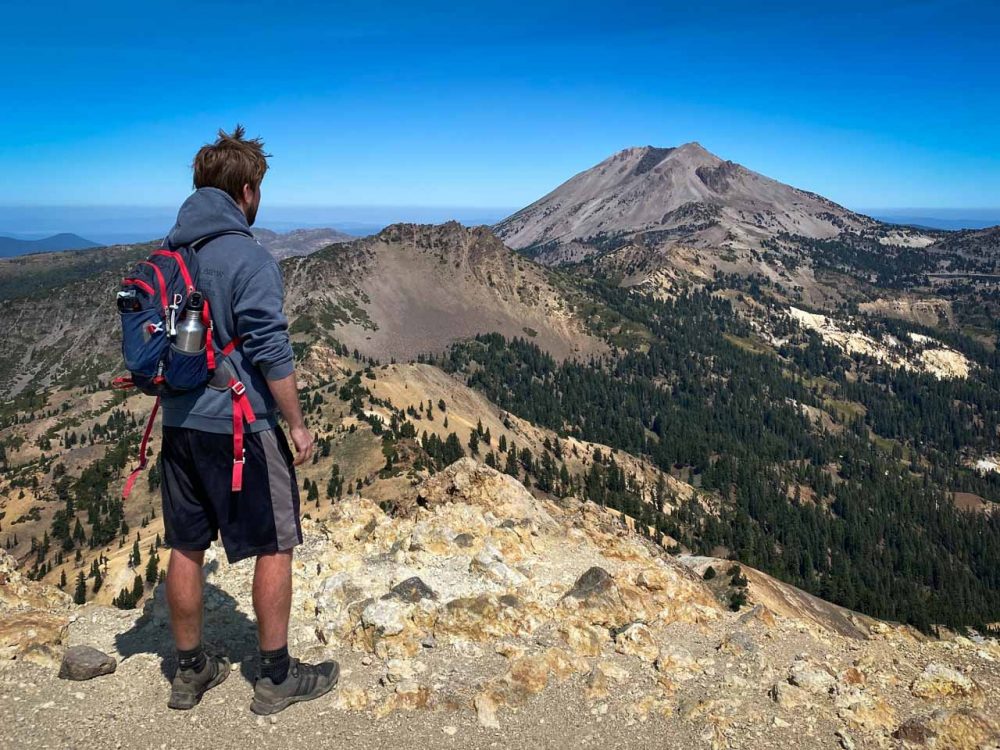
The southernmost volcano in the Cascade Range, Lassen Peak is the centerpiece in northern California’s Lassen Volcanic National Park, one of the greatest national parks near San Francisco. This striking mountain is one of the most active volcanoes in the contiguous United States.
It’s also the biggest plug dome volcano on the planet, a massive natural attraction surrounded by many smaller volcanoes, fumaroles, boiling mud pools, pristine lakes and wildflower-filled meadows.
If you’re looking for the best national parks for volcanoes, Lassen Volcanic National Park is absolutely one of them. It’s the only American national park that comes close to Yellowstone in terms of hydrothermal features.
Although Lassen Volcanic might be less famous than other California national parks, it’s undeniably extraordinary—one of only a handful of places in the world where you can see all four volcano types (cinder cone, plug dome, composite and shield).
It’s the southernmost destination on a road trip to the national parks of the Pacific Northwest. This epic drive also includes above-mentioned Crater Lake and Mount Rainier, as well as Redwood and Olympic.
Death Valley National Park, California
Mostly known for being the lowest, hottest and driest place in North America, Death Valley also has its own volcanic area. Situated in the northern part of vast Death Valley National Park, the Ubehebe Crater is a maar volcano, which originated through a series of gas and steam explosions.
Numerous other, smaller maar volcano craters dot the area around the large Ubehebe Crater, which is half a mile wide. Additionally, you’ll also find plenty of cinders in the vicinity.
The Ubehebe Crater can be admired easily from the parking area on its rim, but the 1.5-mile round-trip hike to the bottom is definitely the best way to experience it.
Hawai’i Volcanoes National Park, Hawaii
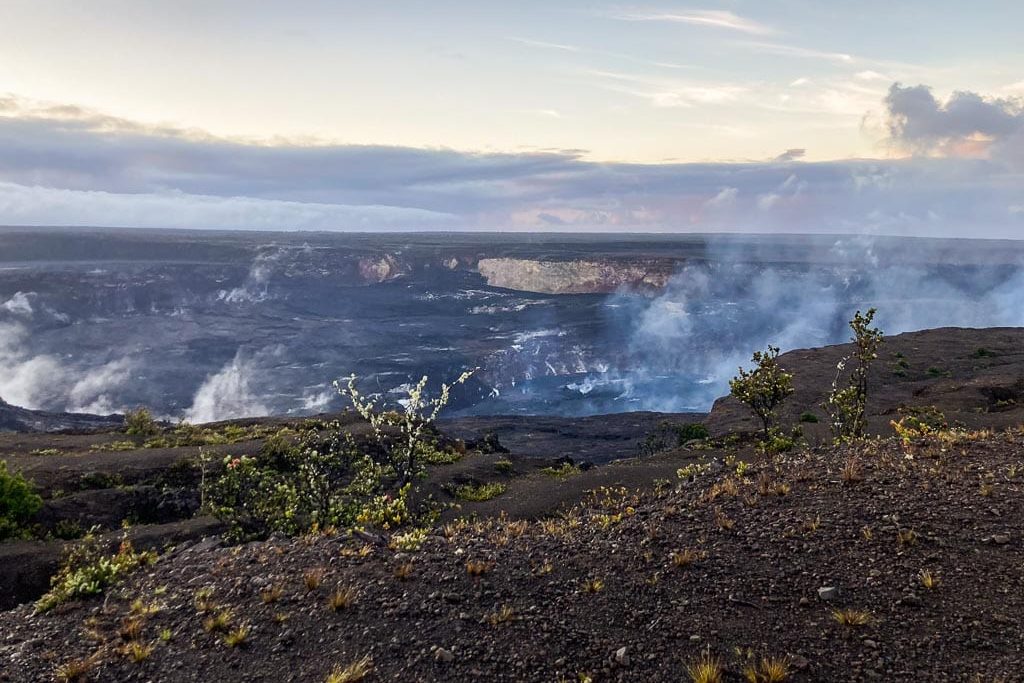
The epitome of a volcanic national park, Hawai’i Volcanoes National Park on the Big Island is home to two of the largest and most active volcanoes on the planet.
Kīlauea is an extremely active volcano, having almost continuously erupted since the 1980’s. Constant lava flows from the caldera run down its slopes and directly into the ocean, effectively creating new land right in front of visitors’ eyes.
The second major volcano in Hawai’i Volcanoes National Park is Mauna Loa.
With its total height of approximately 56,000 feet (17,000 meters) from the ocean floor to its summit, it’s one of the most massive mountains on Earth. (From base to top, that’s over 27,000 feet (8,230 meters) higher than Mount Everest!)
In both volume and mass, it’s considered the world’s largest volcano. Together with Mount Rainier, Mauna Loa is one of the two American “Decade Volcanoes”.
So, as far as national parks with volcanoes go, Hawai’i Volcanoes National Park is as good as it gets. Because of the park’s exceptional natural value, it’s both an International Biosphere Reserve and a UNESCO World Heritage Site.
Several awesome hiking trails allow you to explore these unique landscapes from up-close, while a few scenic roads lead to different areas in the park.
In terms of accommodation in Hawai’i Volcanoes National Park, you can choose from historic Volcano House, a couple of campgrounds and tons of options in nearby Volcano Village.
Haleakala National Park, Hawaii
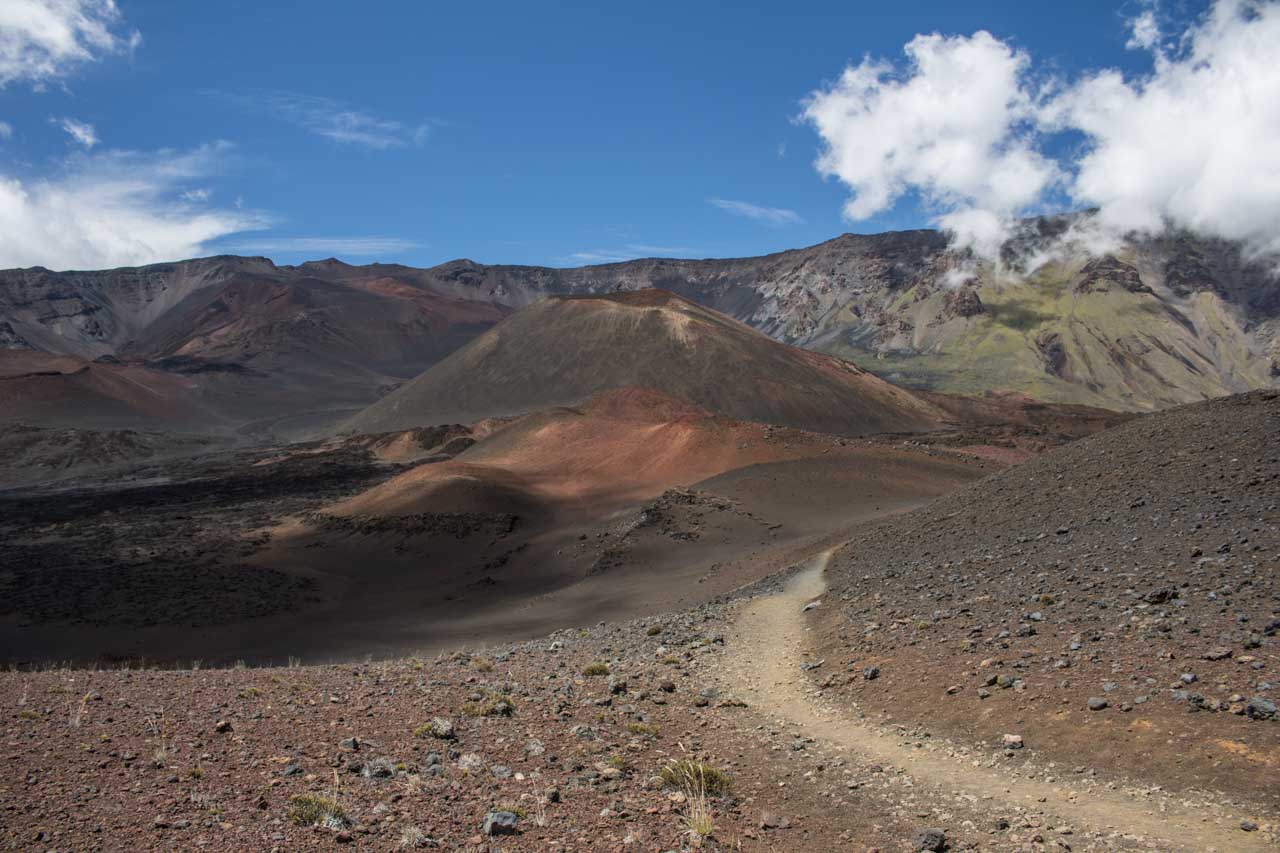
The second volcano national park in Hawaii, Haleakala National Park is on Maui and protects colorful Haleakala Crater, the volcano summit and a coastal rain forest.
The summit area is of most interest to volcano enthusiasts, a huge area dotted with various volcanic features.
Situated 10,000 feet above the Pacific Ocean, this enormous mountain offers some of the most remarkable mountain landscapes you’ll ever see. Calling them “moonscapes” would actually be more appropriate, since they consist of huge pumice valleys, rocky cliffs and cinder cones.
The Haleakala Summit, reachable via a winding two-lane road, is especially popular at sunrise and sunset. Nights, on the other hand, provide spectacular stargazing when the sky is clear (which happens quite a lot).
This exactly is why I recommend camping at Haleakala at least for one night.
It’s a super-popular destination among amateur astronomers, as well as for overnight backpacking trips and bird watching. The Sliding Sands Trail into the Haleakala Crater is one of the National Park Service system’s greatest day hikes.
Katmai National Park, Alaska
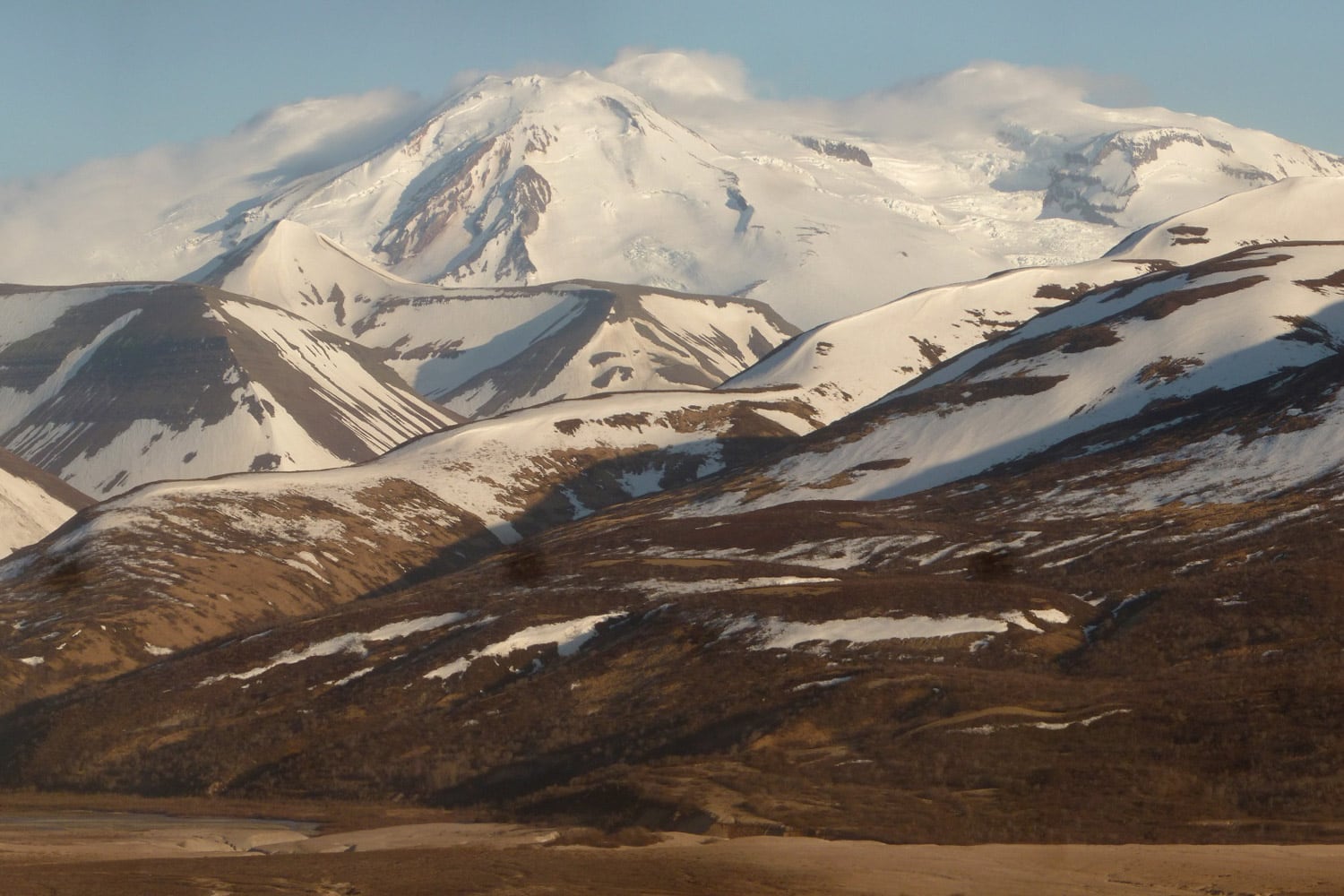
While Alaska’s Katmai National Park is most renowned for its sensational brown bear watching, it’s also one of the national parks with the most volcanic activity in America.
Its centerpiece and namesake is Mount Katmai with its huge lake-filled caldera. The crater lake was created after the 1912 Novarupta eruption, the world’s largest volcanic eruption of the 19th century.
Katmai National Park was established a few years later, in 1918, to protect the destroyed area around Novarupta and the beautifully named Valley of Ten Thousand Smokes.
In addition to Mount Katmai and Novarupta, the park is home to more than a dozen other volcanoes as well, including active Mount Trident, Fourpeaked Volcano and Mount Martin.
Although it was created because of its wealth of volcanic history and features, Katmai National Park has become world-famous for its fantastic bear watching and salmon fishing. It’s one of the best Alaska national parks for wildlife watching.
Lake Clark National Park, Alaska
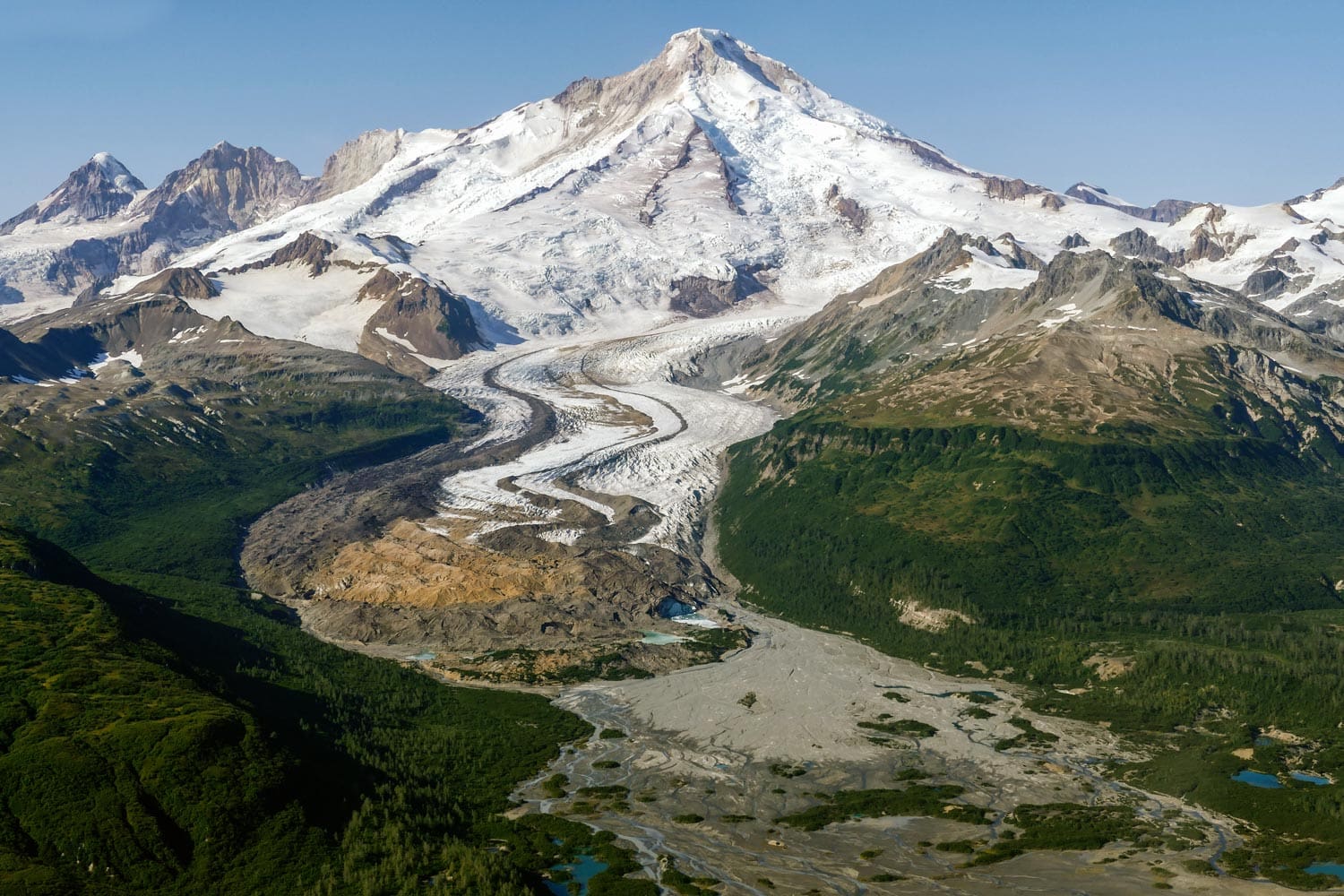
One of the least-visited national parks in America, Lake Clark National Park is all about wilderness. As the National Park Service puts it:
Lake Clark is a land of fire and ice, dominated by two active volcanoes and over 900 square miles of glaciers.
Those two volcanoes in Lake Clark National Park are Redoubt Volcano and Iliamna Volcano, respectively 10,197 feet (3,108 meters) and 10,016 feet (3,053 meters) high.
The park’s maze of deep valleys, craggy crests, jagged summits, mirror-like lakes, salmon-filled rivers and alpine tundra represents the ultimate image of Alaska.
There are no roads here; the only way to access Lake Clark is by floatplane. It’s a destination suitable only to experienced hikers and campers with plenty of backcountry survival skills.
Wrangell-St. Elias National Park, Alaska
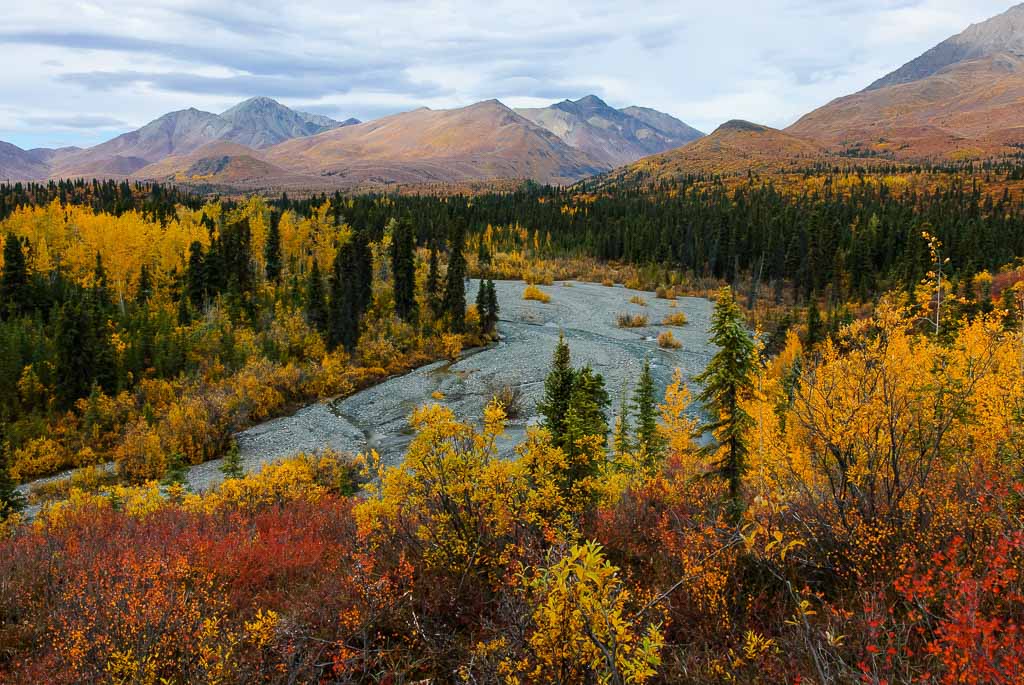
The epitome of all things Alaska has to be Wrangell-St. Elias National Park. Comprising a mind-boggling 13.2 million acres (about 53,300 square kilometers), it’s by far the largest national park in America. It’s larger than Yellowstone, Yosemite and Switzerland combined—bigger than several American states.
It’s the ultimate wilderness park in more than one way. Access into its heart is virtually non-existent, while its various habitats range from alpine tundra and icefields to towering mountain ranges and temperate rain forests.
The park encompasses the St. Elias Mountains, which include the majority of North America’s highest peaks. Mount St. Elias, one of the park’s two namesake mountains, is the second-tallest mountain in the United States—only Denali is higher. Another major mountain in the St. Elias Range is Mount Churchill, which is an active volcano.
The park’s second namesake mountain is Mount Wrangell, 14,163 feet (4,317 meters) high and currently the only active volcano in the Wrangell Mountains.
Although the other major peaks in that mountain range are no longer active, they’re all volcanic in origin. Many of them are (or were, depending on how you look at it) among the world’s largest volcanoes.
Yellowstone National Park, Wyoming, Idaho and Montana
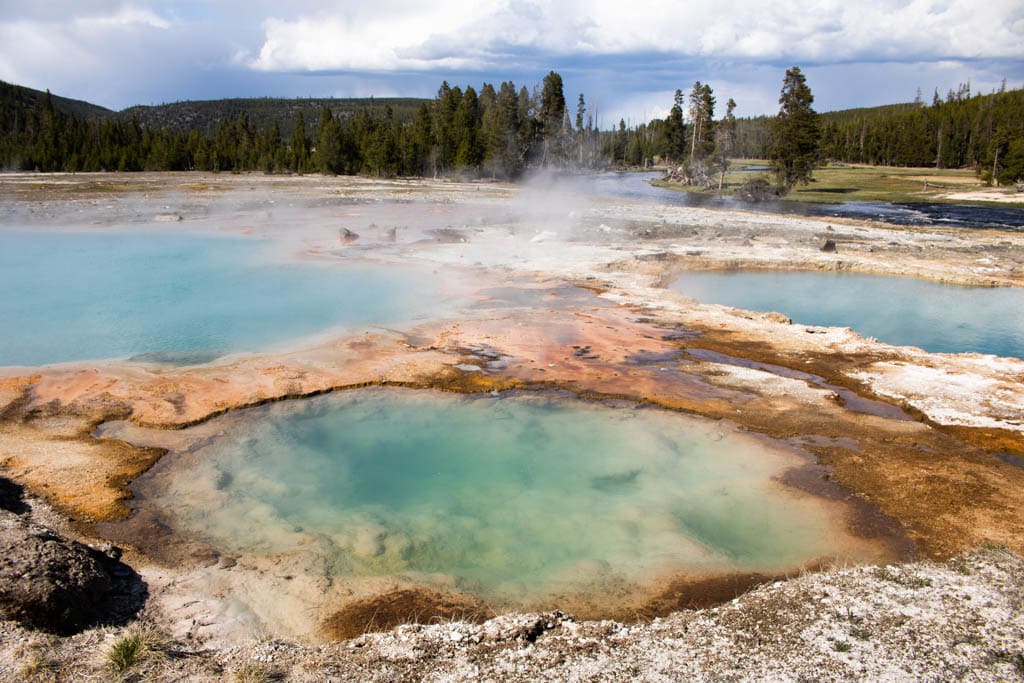
The oldest national park in America, Yellowstone National Park is one of the country’s greatest attractions. In terms of natural beauty, it’s right up there with Yosemite National Park and Grand Canyon National Park as America’s most cherished natural treasures.
Established in 1872, the park protects a variety of natural features, from subalpine forests to deep canyons and lakes.
It’s its abundance of hydrothermal features, however, that makes Yellowstone so exceptional. The park sits on top of the Yellowstone Caldera, the largest supervolcano in North America.
It’s essentially one enormous volcano.
You’ll realize this as you walk between and among boiling mud pots, hot springs and erupting geysers. Stay on the boardwalks and pay attention to warning signs!
Yellowstone is home to a tremendous concentration of those hydrothermal features—more than 10,000 of them. For example, half of all geysers in the entire world are in this national park. Among the top hydrothermal attractions in Yellowstone are Old Faithful and Grand Prismatic Spring.
Additionally, Yellowstone is also home to tons of wildlife, including American bison, grizzly bears, wolves and elk. It’s arguably the best place in the U.S. to see megafauna in their natural habitat.
Major National Park Volcanoes in America
To summarize, this is a brief overview of the fifteen major volcanoes in national parks of America. Note that there are dozens more individual national park volcanoes, though. This is simply a quick list of the volcanoes mentioned in this post.
- Mount Rainier, Washington – Mount Rainier National Park
- Mount Mazama, Oregon – Crater Lake National Park
- Lassen Peak, California – Lassen Volcanic National Park
- Ubehebe Crater, California – Death Valley National Park
- Kīlauea, Hawaii – Hawai’i Volcanoes National Park
- Mauna Loa, Hawaii – Hawai’i Volcanoes National Park
- Haleakala, Hawaii – Haleakala National Park
- Mount Katmai, Alaska – Katmai National Park
- Mount Trident, Alaska – Katmai National Park
- Fourpeaked Volcano, Alaska – Katmai National Park
- Redoubt Volcano, Alaska – Lake Clark National Park
- Iliamna Volcano, Alaska – Lake Clark National Park
- Mount Churchill, Alaska – Wrangell-St. Elias National Park
- Mount Wrangell, Alaska – Wrangell-St. Elias National Park
- Yellowstone Caldera, Wyoming – Yellowstone National Park
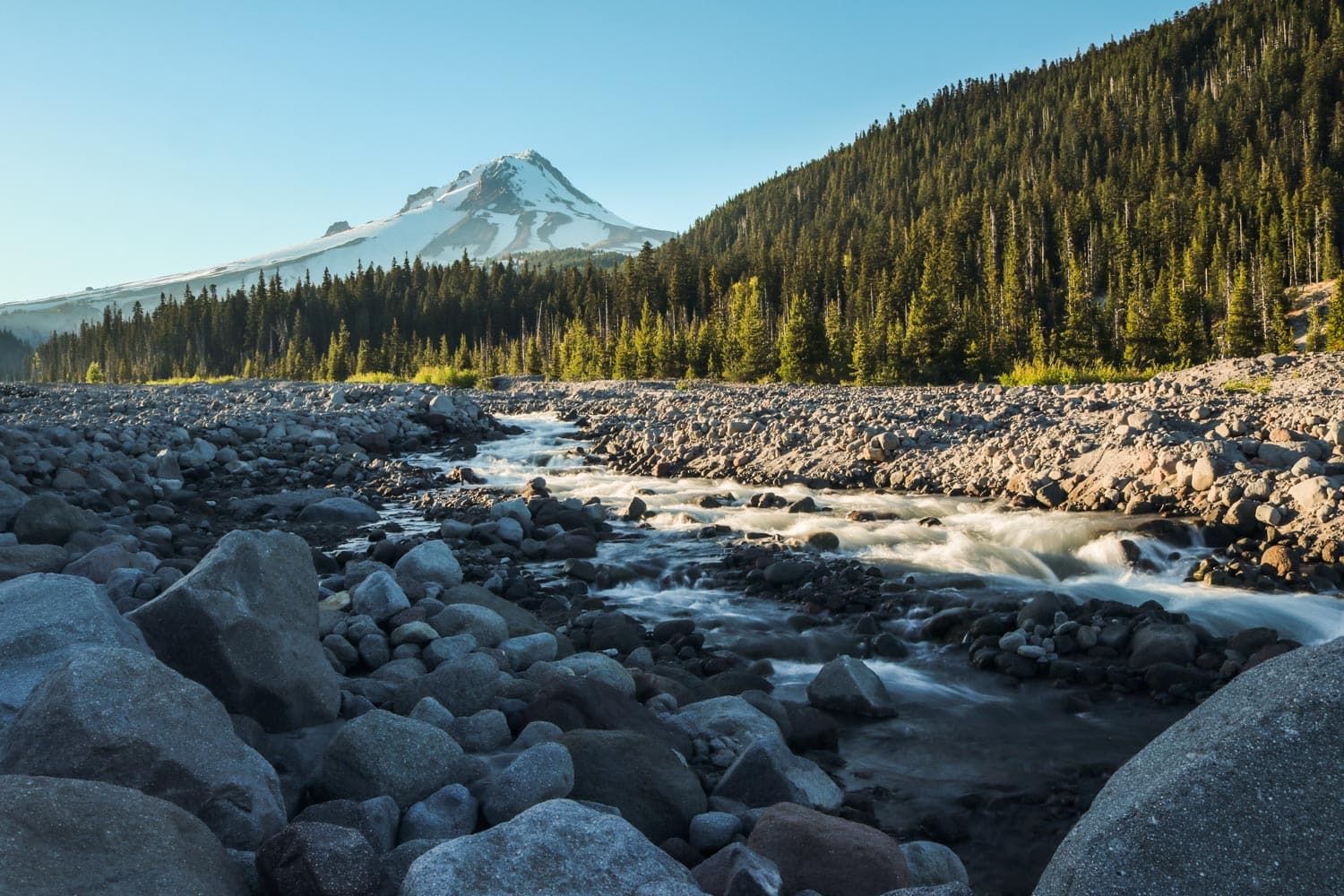
Other Pacific Northwest Volcano Parks in the United States
Besides these national parks with volcanoes, there are also several other amazing volcanic parks in the U.S. Here are some of my favorites in the Cascade Volcanic Arc in the Pacific Northwest:
- Mount Baker-Snoqualmie National Forest, Washington
- Mount St. Helens National Volcanic Monument, Washington
- Gifford-Pinchot National Forest, Washington
- Hood National Forest, Oregon
- Deschutes National Forest, Oregon
- Newberry National Volcanic Monument, Oregon
- Shasta-Trinity National Forest, California
How Many U.S. National Parks With Volcanoes Have You Visited? What Are Your Favorite Volcanoes in America? Tell Us in the Comments Below!
Other Best National Parks for…
- Best National Parks for Waterfalls
- Best National Parks for Wildflowers
- Top Urban National Parks in America
- Fun National Parks to Visit With Dogs
- Best National Parks to Visit in Summer
- Best National Parks to Visit in Spring
- Best National Parks to Visit in Fall
- Best National Parks to Visit in Winter
- Top National Parks for Road Cycling
- Top National Parks for Snowshoeing
- Best National Parks for Stargazing
- Best National Parks for Northern Lights
- National Parks With Native American Cultural Sites
- National Parks With Dinosaurs and Other Fossils
